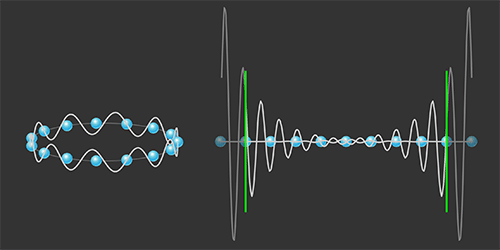Bloch Theory Scratches the Surfaces
Finding the quantum states of electrons in a crystal should be a Herculean task. Thankfully, Bloch’s theory simplifies the problem by specifying that every electron’s wave function is the product of a plane wave and a function with the spatial periodicity of the crystal. The theory is the basis for calculating a solid’s band structure and its thermodynamic and transport properties. However, these calculations sweep the crystal’s surfaces under the rug by assuming periodic boundary conditions—basically, that the crystal wraps onto itself like a torus, and its electrons see a never-ending periodic lattice. Researchers at Dartmouth College in New Hampshire and Indiana University in Bloomington have instead put the crystal’s surface and interior (bulk) on equal footing by extending Bloch’s theory. Their results will be useful for describing topological materials as well as materials with surface superconductivity or surface magnetism.
The researchers imagine a crystal with general boundary conditions, such as sharp or gradual cutoffs of the crystalline lattice along one or more directions. Using an approach they had described in Physical Review Letters and in Journal of Physics A, they rewrite the Hamiltonian for electrons on the lattice in such a way that they obtain separate equations for the bulk and surface electron wave functions. The new equations, which can be solved exactly, often in analytical form, open opportunities for future research. One is developing a mathematical description of the so-called bulk-boundary correspondence, which connects a solid’s surface states to the topology of its bulk band structure. Another possibility is to engineer, from scratch, lattices whose surface electrons have desirable functional properties.
This research is published in Physical Review B.
–Jessica Thomas
Jessica Thomas is the Editor of Physics.





